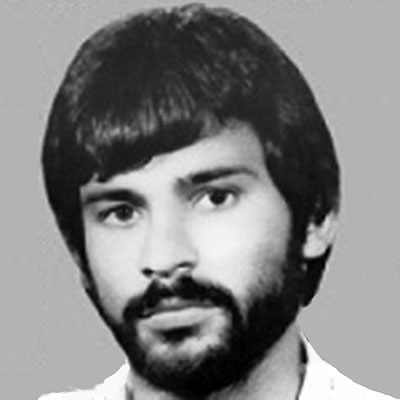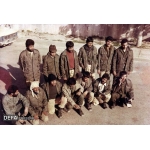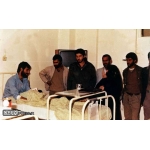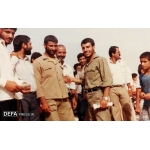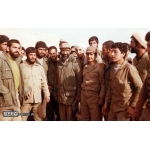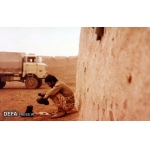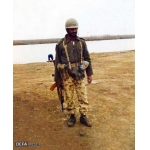Mahini, Alireza
Hoda Musavi
250 بازدید
Alireza Mahini (1956–1981) served as a commander in Dr. Mustafa Chamran's Irregular Warfare Headquarters and a military commander during Operation Tariq al-Quds. He was martyred in the Operation Chazabeh.
Alireza Mahini was born on March 21, 1956, in Jalali village, six kilometers south of Bushehr.[1] He completed his primary and intermediate education in Bushehr. He continued his studies at Haj Jasem Technical School, earning a diploma in electrical engineering.[2] He was admitted to the University of Science and Technology in Tehran to study electronics but was expelled due to his political activities. Mahini later completed his education in electronics at Iran-Mehr Higher College. During his studies, he engaged in political and social activities against the Pahlavi regime, including guerrilla training and organizing group mountain climbing.[3]
After graduation, Mahini began his military service in Tehran, coinciding with the public’s revolutionary activities of 1979 against the Pahlavi regime. During this time, he participated in political demonstrations and distributed leaflets containing Imam Khomeini's messages and remarks.[4]
After the victory of the Islamic Revolution, he taught at Saadat High School and Haj Jasem Technical School in Bushehr for a brief period of time.[5]
At the outbreak of the Iran-Iraq War in 1980, Mahini joined Dr. Mustafa Chamran's Irregular Warfare Headquarters[6] where he became responsible for recruiting volunteers in Bushehr Province.[7] Dr. Chamran appointed him as the commander of operational battalions.[8]
On January 5, 1981, during Operation Nasr and the liberation of Hoveyzeh, he led his forces from Kouheh village near Hamidiyeh toward Hoveyzeh. However, in Farsieh, 40 kilometers from Hoveyzeh, due to a lack of sufficient ammunition and intense enemy attacks, they were forced to retreat.[9]
In 1981, Mahini was dispatched with a group to scout the operational area of Dehlavieh.[10] On June 11, 1981, Dr. Mustafa Chamran's Irregular Warfare group crossed the Karkheh River, attacked Iraqi forces, and liberated the Dehlavieh area. However, they were unable to hold the territory and eventually retreated with the help of the 55th Airborne Brigade of the Islamic Republic of Iran Army, positioning in a location 300 meters away from Dehlavieh.[11]
On June 21, 1981, Dr. Chamran was martyred by shrapnel from a mortar explosion in the Dehlavieh front.[12] Alireza Mahini was also injured in the abdomen and right shoulder by gunfire but returned to the front lines after one day of treatment in the hospital.[13] Following Dr. Chamran's martyrdom, a part of the Irregular Warfare Headquarters came under Mahini's command.[14]
Operation Tariq al-Quds, which began on November 30, 1981, saw Mahini commanding[15] the vanguard forces, [16] advancing from the Sableh River.[17] During the operation, he was wounded in the leg by shrapnel.[18]
After the operation, the Irregular Warfare Headquarters was disbanded, and its forces and resources were transferred to the Islamic Revolutionary Guard Corps (IRGC).[19] Mahini, through Bushehr's central Basij, took steps to rejoin the war fronts. The forces were sent from Bushehr to the Shahid Dastgheib Training Camp in Kazeroon. After taking a 20-day training course, Mahini and several others were dispatched to the Shahid Beheshti Camp, south of Ahvaz.[20]
On February 5, 1982, the Iraqi army launched a heavy assault in the Chazabeh area.[21] In response, on February 6,[22] a defensive operation was carried out with the participation of the IRGC and the Islamic Republic of Iran Army.[23]
During this operation, on February 12, 1982, Alireza Mahini was martyred after shrapnel struck his head.[24] His body was moved to Bushehr, where he was laid to rest following a funeral in the city.
His martyrdom inspired the Iranian forces in Bushehr. Therefore, following the funeral ceremony, more than two battalions of Bushehr combatants were dispatched to the front lines.[25]
[1] Daftare Pajoohesh-haye Farhangi Bonyad Shahid va Omur Eysargarane, Farhange Alam-e Shuhada-ye Ostan-e Bushehr (Encyclopedia of Martyrs of Bushehr Province), Vol. 3, Tehran: Shahid, 1392, p. 197.
[2] Mahini, Ismail, Shahid Doktor Chamran va Malik Ashtar (Martyr Dr. Chamran and Malik Ashtar), Qom: Amir-al-Elm, 1391, p. 42.
[3] Bakhtiari Daneshvar, Davood, Bache-Mahalle Jallali (The Boy from Jallali Neighborhood), Tehran: Soreh Mehr, 1385, p. 20.
[4] Heyat-e Razmandegan-e Eslam-e Shahrstan-e Bushehr, Ghoroub-e Chazabeh (The Sunset of Chazabeh), Setad Barghozari-ye Yadvareh Sardar Jang-haye Namonazzam Shahid Ali Reza Mahini (The Headquarters of the Memorial Ceremony of Martyr Ali Reza Mahini), Tehran: Setad Barghozari-ye Yadvareh, 1374, p. 14; Shokouhi, Jamshid, Ba Paye Khasteh Raftan (With Tired Feet Walking), Bushehr: Shoru, 1381, p. 11.
[5] Shokouhi, Jamshid, Ba Paye Khasteh Raftan (With Tired Feet Walking), Pp. 11 and 12.
[6] Heyat-e Razmandegan-e Eslam-e Shahrstan-e Bushehr, Ghoroub-e Chazabeh (The Sunset of Chazabeh), p. 15.
[7] Mahini, Ismail, Pishtezan-e Fath (The Pioneers of Victory), Vol. 1, Qom: Amir-al-Elm, 1391, p. 95.
[8] Mahini, Ismail, Shahid Doktor Chamran va Malik Ashtar (Martyr Dr. Chamran and Malik Ashtar), Pp. 43-45.
[9] Shokouhi, Jamshid, Ba Paye Khastah Raftan (With Tired Feet Walking), Pp. 36 and 37.
[10] Ibid, Pp. 58-87.
[11] Jafari, Mojtaba, Atlas-e Nabard-haye Mandegar (Atlas of Eternal Battles), Tehran: Soreh Sabz, Ch. 35, 1389, p. 58.
[12] Alayi, Hussain, Ravand-e Jang-e Iran va Araq (The Course of the Iran-Iraq War), Vol. 1, Tehran: Markaz-e Asnad va Tahqiqate Defa Moqadas (The Center for Documents and Research on the Sacred Defense), 1391, p. 315.
[13] Mahini, Ismail, Shahid Doktor Chamran va Malik Ashtar (Martyr Dr. Chamran and Malik Ashtar), Pp. 58-87.
[14] Bakhtiari Daneshvar, Davood, Bache-Mahalle Jallali (The Boy from Jallali Neighborhood), Pp. 10 and 11.
[15] Mahini, Ismail, Shahid Doktor Chamran va Malik Ashtar (Martyr Dr. Chamran and Malik Ashtar), p. 66.
[16] Bakhtiari Daneshvar, Davood, Bache-Mahalle Jallali (The Boy from Jallali Neighborhood), p. 30.
[17] Mahini, Ismail, Shahid Doktor Chamran va Malik Ashtar (Martyr Dr. Chamran and Malik Ashtar), p. 68.
[18] Heyat-e Razmandegan-e Eslam-e Shahrstan-e Bushehr, Ghoroub-e Chazabeh (The Sunset of Chazabeh), Pp. 144 and 145.
[19] Nabi, Karimi and Behroozi, Farhad, Taqvime Tarikh-e Defa Moqadas (The Calendar of the Sacred Defense History), Vol. 18: Nabard-e Chazabeh (The Battle of Chazabeh), Tehran: Markaz-e Asnad-e Enqelab-e Eslami, 1384, p. 416.
[20] Shokouhi, Jamshid, Ba Paye Khastah Raftan (With Tired Feet Walking), p. 74.
[21] Alayi, Hussain, Ravand-e Jang-e Iran va Araq (The Course of the Iran-Iraq War), p. 394.
[22] Jafari, Mojtaba, Atlas-e Nabard-haye Mandegar (Atlas of Eternal Battles), p. 70.
[23] Ibid, p. 72.
[24] Daftare Pajoohesh-haye Farhangi Bonyad Shahid va Omur Eysargarane, Farhange Alam-e Shohada-ye Ostan-e Bushehr (Encyclopedia of Martyrs of Bushehr Province), p. 197.
[25] Shokouhi, Jamshid, Ba Paye Khastah Raftan (With Tired Feet Walking), Pp. 77 and 78.


